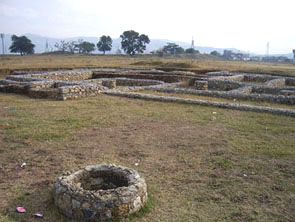The Bhir Mound is the oldest of the ruins of Taxila in the
Punjab province of Pakistan.
The ruins of Bhir Mound were excavated from 1913-1925 by Sir John Marshall. The work was
continued by Sir Mortimer Wheeler in 1944-1945 and by Dr.
Mohammad Sharif in 1966-1967. Further excavations were performed
in 1998-2000 by Bahadur Khan and in 2002 by Dr. Ashraf and
Mahmud-al-Hassan.
 The ruins of the town form an irregular shape measuring around 1
km from north to south and about 600 meters from east to west.
The oldest part or layer of these ruins is from the sixth and
fifth centuries BC. The second layer is from the fourth century
BC and existed at the time of the invasion of Alexander the
Great. The third layer is from the time of the Maurya kings of
India (third century BC). The fourth and topmost stratum
contains the constructions from time after the Mauryan period.
The ruins of the town form an irregular shape measuring around 1
km from north to south and about 600 meters from east to west.
The oldest part or layer of these ruins is from the sixth and
fifth centuries BC. The second layer is from the fourth century
BC and existed at the time of the invasion of Alexander the
Great. The third layer is from the time of the Maurya kings of
India (third century BC). The fourth and topmost stratum
contains the constructions from time after the Mauryan period.
The streets of the city show that they were narrow and the house
plans were very irregular. There is little evidence of planning
- most of the streets are very haphazard. The houses had no
windows to the outside. They opened towards inner courtyards.
The courtyard was open and 15 to 20 rooms were arranged around
it.
ITINERARY:
Day 1: Arrival Islamabad transfer to
Hotel for overnight stay
Day 2: Islamabad - Taxila
After breakfast we will start our tour by visiting the
historical and once Buddhist Kingdom Taxila, it is 39 Km from
Islamabad, on arrival at Taxila we will visit the rich Taxila
museum, some of the artifact found during excavation in Taxila
are displayed in the museum and it has a very good collecting of
Gandhara art with pictures of the archeological sites of the
Region., afternoon lunch at PTDC motel, after lunch visit the
historical sites of Taxila first Bhir mound.
Bhir mound Taxila: Situated on small plateau Bhir
mound is the remains of once a hustling bustling city flourished
in 6th century B.C, it was in its peak till Alexander the great
arrive on 327 B.C, King Ambi was the ruler of Bhir mound when
Alexander arrived in Taxila, he was welcomed here , and this was
the main reason of his down fall, after this welcome, some of
the Alexander’s Army refused to go further and decided to built
a new city with the name of Sirkap, after the Bactrian Greek’s
built Sirkap the oldest City Bhir mound which had no match to
Sirkap with modern neglected and the down fall Bhir mound
started, in Bhir mound there is very little left to see but the
foundation stones gives you the evidence that the street were
narrow houses plans were irregular.
Dharmarajika Stupa: Dharmarajika is relic Stupa;
it was build by King Ashoka of Mouryan dynasty in 3rd century
B.C, it is the earliest settlement of the Buddhist era which
later flourished in Far East, it has many memorials and votive
stupas near the relic stupa, during 2nd century A.D it was the
largest shrine there are lot of small settlements or the Monks
chapels but only foundations are still intact. After noon return
to Taxila dinner and overnight at PTDC Motel Taxila.
Day 3: Taxila visit Julian Mohra
Muradu and Sirkap and afternoon drive to Peshawar
After break fast start with the visit of Sirkap the Greek city,
it’s well planned city the columns and the remains of a double
headed eagle gives us the advance of the Bactrian Greeks, it is
not say that the city entirely Greek it has the Indian
influence.
The city was has seen 3 different times the Corinthian ceythian
and the Parthian dynasties, after the visit we will move to
Julian.
Julian was the first ever a ministry which had played a modern
roll of university, the monastery has one relic stupa surrounded
by many memorial stupas built by the devotees’ visited during
2nd century till the white Hanz arrived in 5th century A.D., it
has monastic complex monks chapels, a water pound, an assembly
hall and the kitchen next to man monastery, it is believed that
almost 150 monks use to study at the monastery. (Lot of history
we can explain during tour). After a short visit of Mohra Muradu
site before returning to hotel for lunch and then drive to
Peshawar.
After lunch drive to Peshawar via G.T road, it connects Kabul
via Khyber Pass to Kolkata.( the road which has lot of history
and saw may invaders , traders and travelers travelling from
Kabul to Kolkata India and to Europe, that includes Alexander
the great ,Chandragupta Moria, Sher Shah Suri ( who built the
Rothas fort), Mehmood of Ghaznavi, Moguls, Ranjeet Singh, The
British colonial armies.
Afternoon we will reach Peshawar, transfer to Hotel for dinner
and overnight stay.
Day 4: full day Visit of Peshawar
After breakfast we will visit the Peshawar museum, which has 3
different portion dedicated to one for Gandhara Era, one for the
Ethnic and tribes of North West Frontier and Kalash and Chitral.
Afternoon visit to historic Qissa-Khawani bazaar( the story
tellers bazaar) , once a hustling bustling street with traders
sharing their stories to traders coming from opposite direction
sitting in the small tea shops while there horses, camels tied
up and fed in the Caravan Saries. Peshawar is very rich and an
identical Mogul city like Lahore and Delhi inside with 11 walls,
which used to closed after 10 pm at night about 120 years a go,
evening return to hotel for dinner and night stay.
Day 5: Peshawar
– Swat via Charsaddah, Takhtibai
After breakfast drive to Swat via Charsaddah
(the modern in older times it was called Pushkalavati the
capital of Ghandhara), Shabaz ghadi (the little town which as
the inscriptions of Kharoshti written in a Stone by the Buddhist
pilgrims in the era of Ashoka Kingdom), Takhtibai, it is
situated on a mountain top with lot of stupas and place for
meditation and Monks chapels, after visiting continue drive to
Swat via Malakand Pass, a short stop at the pass, this was the
pass where Churchill fought the armies of Wali of Swat a young
lieutenant, drive to Swat on arrival transfer to hotel for
dinner and overnight.
Day 6:
Swat City Excursion
After breakfast drive to Swat Museum and the Buddhist sites
for full day evening dinner and overnight at Hotel.
Day 7:
Swat Islamabad via Malakand
After breakfast drive back to Islamabad via Malakand pass
Nowshera Attock, arrive Islamabad transfer to Hotel for dinner
and overnight.
Day 8:
Full excursion to Rothas Fort and Mankiala Stupa
After breakfast we will begin our day with an excursion to
Mankiala stupa (the eastern end of the Gandhara kingdom, it is a
relic stupa stand alone in field of Potohar plateau, after a
short stop continue drive to Rothas Fort, on arrival at Rohtas
we will start visiting the Hawaili Man Singh, and all the gates
and then return to Islamabad for overnight stay at Hotel.
Day 9:
Islamabad Rawalpindi City Sightseeing - flight back
Morning Twin city sight seeing with colorful truck art market in
Rawalpindi the British colonial town and Islamabad the modern
City of Pakistan with Lok Virsa art museum and the Damane-Koh ,
the view point on the foot hills of Islamabad, evening drive to
Islamabad airport for flight to the destination.





















